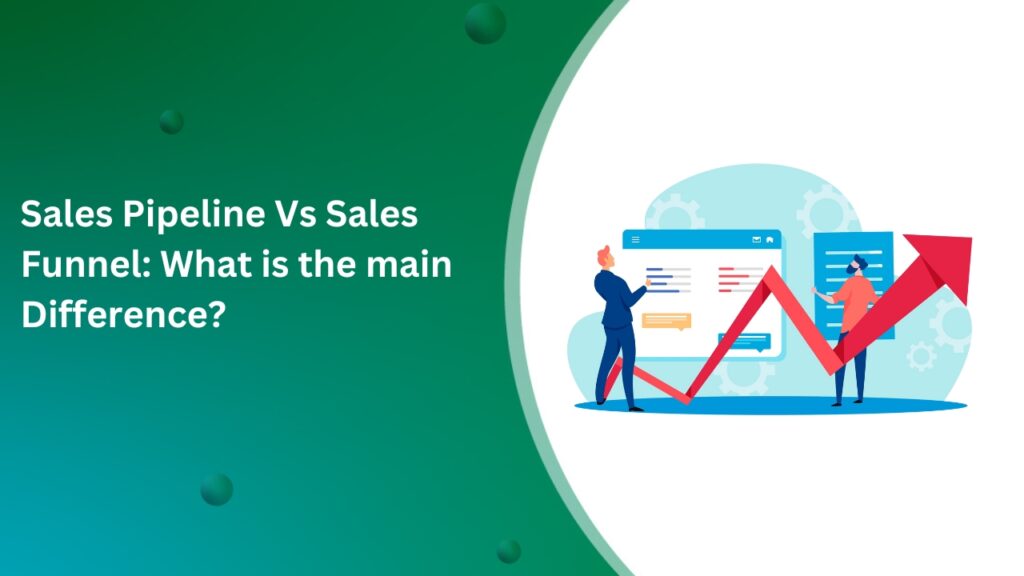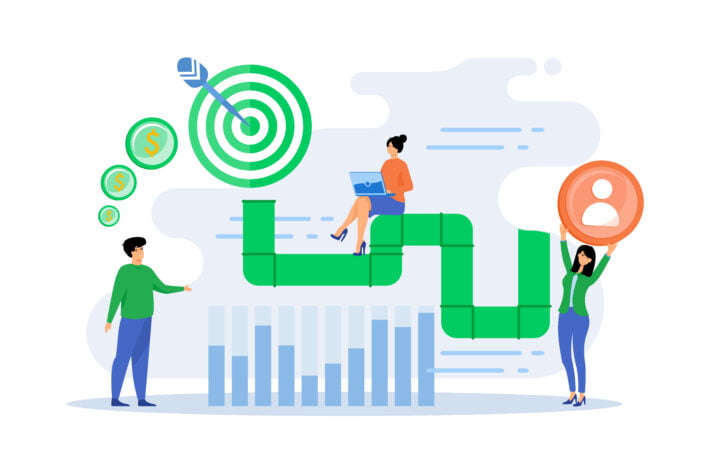Sales Pipeline vs Sales Funnel | Key Differences Explained

Sales is the heart of any business. It’s what keeps things running, bringing in new customers and helping the company grow. To manage sales effectively, businesses often rely on two important concepts: the sales pipeline and the sales funnel. These terms are commonly used, but many people confuse them or use them interchangeably.
Understanding the difference between the two is essential for better sales management. While they both represent different parts of the sales process, they focus on different things—one looks at the business’s steps to close deals, and the other focuses on the customer’s journey to making a purchase. In this blog, we’ll break down what sets them apart and why knowing both can improve your sales strategy.
What is a Sales Pipeline?
A sales pipeline is a visual representation of where your prospects are in the sales process. Think of it as a roadmap that shows the journey a potential customer takes from the first point of contact to closing the deal. It’s divided into stages, and each stage represents a specific step in the sales process.
Key Stages in a Sales Pipeline
- Prospecting: Finding potential customers who might be interested in your product or service.
- Qualification: Determining if the prospect is a good fit for your offering.
- Meeting/Demo: Presenting your product or service to the prospect.
- Proposal: Sending a formal offer or quote.
- Negotiation: Discussing terms, pricing, or any objections.
- Closing: Finalizing the deal and getting the customer to sign on the dotted line.
The sales pipeline is all about tracking the progress of individual deals. It helps sales teams understand how many deals are in each stage, how long they’ve been there, and what actions are needed to move them forward.

How businesses track opportunities at each stage
At each stage, businesses track opportunities to see how close they are to making a sale. For example, if you’re a software company, you might start by gathering leads through online inquiries, then qualify them by checking their needs, set up a demo, and follow up with a proposal. Finally, once everything is agreed upon, you close the deal.
A well-managed Sales Pipeline Vs Sales Funnel ensures that nothing slips through the cracks and helps businesses focus on the most promising opportunities.
What is a Sales Funnel?
A sales funnel, on the other hand, is a broader concept that represents the entire customer journey, from the moment someone becomes aware of your brand to the point where they make a purchase. It’s called a “funnel” because, at each stage, the number of potential customers decreases as some drop out of the process.
Key Stages in a Sales Funnel
- Awareness: The prospect becomes aware of your product or service (e.g., through ads, social media, or word of mouth).
- Interest: The prospect shows interest by engaging with your content, visiting your website, or signing up for a newsletter.
- Consideration: The prospect evaluates your offering and compares it to competitors.
- Intent: The prospect shows intent to buy, perhaps by requesting a demo or adding items to a cart.
- Purchase: The prospect becomes a customer by making a purchase.
- Retention: The post-purchase stage, where you focus on keeping the customer happy and encouraging repeat business.
The sales funnel is more about understanding the customer’s journey and identifying where you might be losing potential customers. It helps you optimize your marketing and sales efforts to convert more leads into paying customers.

Focus on how customers move through different stages
As customers move through the funnel, their number gets smaller, because not everyone who becomes aware of your product will end up purchasing. For example, let’s say you run an online store selling shoes. You might start with 1,000 visitors to your site (Awareness). Out of those, 300 people may browse through different styles (Interest). Of those, 100 may add shoes to their cart (Decision), and finally, 50 people complete their purchase (Action).
The sales funnel helps businesses understand customer behavior and identify where they might be losing potential buyers, so they can improve their sales process.
Sales Pipeline VS Sales Funnel: The Main Differences
Now that we’ve defined both terms, let’s dive into the key differences between a Sales Pipeline Vs Sales Funnel.
1. Focus
- Sales Pipeline: Focuses on the sales process from the seller’s perspective. It’s about tracking deals and managing the steps needed to close them.
- Sales Funnel: Focuses on the buyer’s journey. It’s about understanding how potential customers move through the stages of awareness, interest, and decision-making.
2. Scope
- Sales Pipeline: Narrower in scope. It deals with individual prospects and their progress through the sales stages.
- Sales Funnel: Broader in scope. It looks at the entire customer journey, including marketing efforts and customer retention.
3. Stages
- Sales Pipeline: Stages are specific to the sales process (e.g., prospecting, qualification, closing).
- Sales Funnel: Stages are more general and cover the entire customer journey (e.g., awareness, interest, purchase).
4. Purpose
- Sales Pipeline: Helps sales teams manage their workload, prioritize deals, and forecast revenue.
- Sales Funnel: Helps businesses identify where they’re losing potential customers and optimize their marketing and sales strategies.
5. Metrics
- Sales Pipeline: Tracks metrics like the number of deals in each stage, average deal size, and conversion rates between stages.
- Sales Funnel: Tracks metrics like the number of leads at the top of the funnel, conversion rates from one stage to the next, and overall customer acquisition cost.
Why Both Are Important
While the Sales Pipeline Vs Sales Funnel serve different purposes, they are both crucial for the success of your business. Here’s why:
Sales Pipeline Benefits
- Improved Sales Management: Helps sales teams stay organized and focused on moving deals forward.
- Better Forecasting: Provides insights into how much revenue you can expect in the near future.
- Increased Accountability: Allows managers to track individual performance and identify areas for improvement.
Sales Funnel Benefits
- Optimized Marketing: Helps you understand which marketing efforts are driving the most leads and conversions.
- Higher Conversion Rates: Identifies bottlenecks in the customer journey so you can address them and improve conversion rates.
- Customer Retention: Encourages you to focus on post-purchase satisfaction, leading to repeat business and customer loyalty.
How to Use Both Together
The Sales Pipeline Vs Sales Funnel are not mutually exclusive. In fact, they work best when used together. Here’s how you can integrate them:
- Align Marketing and Sales: Use the sales funnel to identify where leads are coming from and the sales pipeline to manage those leads through the sales process.
- Track Metrics Across Both: Monitor both funnel metrics (e.g., lead generation rates) and pipeline metrics (e.g., deal conversion rates) to get a complete picture of your sales performance.
- Identify Bottlenecks: If you notice a drop-off in the sales funnel, use the sales pipeline to dig deeper and find out where deals are getting stuck.
- Optimize Continuously: Use insights from both the funnel and pipeline to refine your marketing and sales strategies.
Real-Life Example
Let’s say you run an online store selling eco-friendly products. Here’s how the sales funnel and pipeline might work together:
Sales Funnel:
- Awareness: A customer sees your ad on Instagram.
- Interest: They click on the ad and visit your website.
- Consideration: They browse your products and read reviews.
- Intent: They add a product to their cart but don’t check out.
- Purchase: You send a follow-up email with a discount, and they complete the purchase.
Retention: You send a thank-you email and recommend related products.
Sales Pipeline:
- Prospecting: You identify the customer as a lead.
- Qualification: You determine they’re interested in eco-friendly products.
- Meeting/Demo: You send them a personalized email with product recommendations.
- Proposal: You offer a discount to encourage them to complete the purchase.
- Closing: They make the purchase, and you update the pipeline to reflect the closed deal.
Conclusion
In summary, the Sales Pipeline Vs Sales Funnel are two sides of the same coin. The sales pipeline focuses on the steps your sales team takes to close deals, while the sales funnel focuses on the customer’s journey from awareness to purchase. Both are essential for understanding and optimizing your sales process.
By using both the Sales Pipeline Vs Sales Funnel, you can gain a comprehensive view of your sales performance, identify areas for improvement, and ultimately drive more revenue for your business. So, whether you’re a sales manager or a business owner, make sure you’re leveraging both tools to their full potential!
Ready to take control of your sales pipeline? Sign up for a 👉 free trial today or visit our website – www.salestown.in to learn more-!

